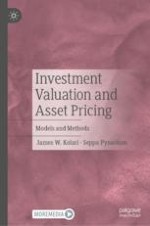2023 | OriginalPaper | Chapter
11. Event Studies
Authors : James W. Kolari, Seppo Pynnönen
Published in: Investment Valuation and Asset Pricing
Publisher: Springer International Publishing
Activate our intelligent search to find suitable subject content or patents.
Select sections of text to find matching patents with Artificial Intelligence. powered by
Select sections of text to find additional relevant content using AI-assisted search. powered by
